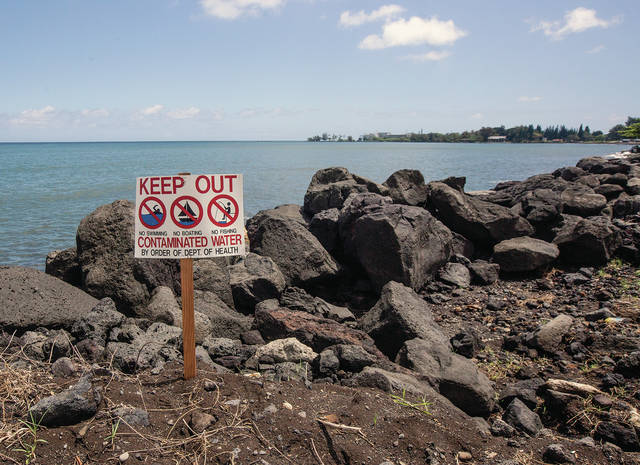HILO — Hawaii County has released sewage spill data in the aftermath of last Monday’s discharge into the Wailuku River and Hilo Bay, and a state microbiologist says the results are reassuring.
“The numbers are really low. If it was a big sewage spill event, we’d see numbers like in the thousands,” said Myron Honda, environmental health specialist with the clean water branch of the state Department of Health.
A sewer line blockage overflowed Monday, April 3, into a manhole that had an unexpected lateral line. That lateral line fed an estimated 41,000 gallons of untreated sewage into the Wailuku River. The Wailuku feeds Hilo Bay, causing the county to close beaches and parks from the river all the way past Coconut Island — essentially every park directly touched by Hilo Bay waters.
Hawaii County data shows that samples taken April 3 in the afternoon, several hours after the sewage first spilled into the bay, produced Enterococci spp.-bacteria colony forming units of 182 CFU and 145 CFU — which is above the 130 CFU national standard considered safe for human activities.
The measurement essentially shows how many cells or small colonies of cells of the bacteria are viable in a petri dish swabbed from a water sample.
But several test locations showed levels far enough below 130 that the Department of Health cleared those locations to reopen Tuesday, April 4, meaning all water areas along Banyan Drive out to Coconut Island were soon bustling with human activity again.
On April 4, results showed that levels at remaining test sites along the Bayfront had fallen to 40 CFU or lower (ranging from 10-40 CFU).
The Health Department then cleared the entire bay to be opened for recreational activities, including swimming and fishing. Tests were done for both Enterococci spp. bacteria and Clostridium perfringens.
Enterococci are bacteria that are accepted as the national standard to test for human fecal matter, Honda said. But Hawaii also tests for Clostridium because Enterococci occur naturally in Hawaii, and Clostridium helps clarify if human fecal matter is truly present. But national standards allow only Enterococci to be used for decision making about public access.
“Our test results go directly to the Department of Health. The Department of Health then responds to us and says when the water is safe,” said Bill Kucharski, director of the Hawaii County Department of Environmental Management.
Enterococci numbers will climb whenever there’s heavy runoff, such as after a big rainfall, Honda said.
Numbers for the Hilo spill stayed high closest to the river, Honda said, and as the spill got closer to the ocean it became diluted.
Numbers in general spike up and down, even without a spill, he said. For example, Waikiki had a spike to 300 CFU that went back down to 2.3 CFU by the next day — with no sewage spill. When such spikes happen, the county notifies the public but then removes signage again.
“At the end of the year, we collect all of this information and we send it to the EPA in a report,” Honda said.
The county’s role is to report its data to the Department of Health. If such spills happen too frequently or are too serious, the state is the entity that determines when intervention is required and will inform a county of needed changes, he said.
Kucharski said he was OK with the county’s response to the spill.
“I would have rather we got there sooner,” he said. But he acknowledged that any time the county responds within 10 minutes he wishes it had been five.
“We need to check the manholes to make sure that this was not a common occurrence for all the manholes,” he said.
County workers are now doing that assessment to make sure there are no other abandoned lateral lines from manholes, especially along the affected line near Hilo High School where the leak occurred.
Kucharski said what happened is “very rare” because there was no pump break, no pipe break and nobody not paying attention who allowed a leak at a repair or construction site. Rather, this was a 10-inch sewage main that simply should not have flowed through a lateral line into the river.
“It’s just not usual to have that kind of line in there,” Kucharski said.
Finding the unexpected was a lesson.
“If it’s on this line, it could be on other locations,” Kucharski said.
He said a full investigation has not been completed, so he won’t make a statement about how the sewage-line might have become blocked. A county spill report said the “county jail” (Hawaii Community Correctional Center) might be where the materials found in the blockage came from. Items mentioned as being in the blockage, so far, include shirts, rags, candy wrappers, a 12-inch chisel and plastic bags.
Kucharski said he had “no knowledge” if county workers found something stamped with the logo of any particular facility. Connected to the sewage main are HCCC, Hilo Medical Center and Hilo High.
Email Jeff Hansel at jhansel@hawaiitribune-herald.com.






